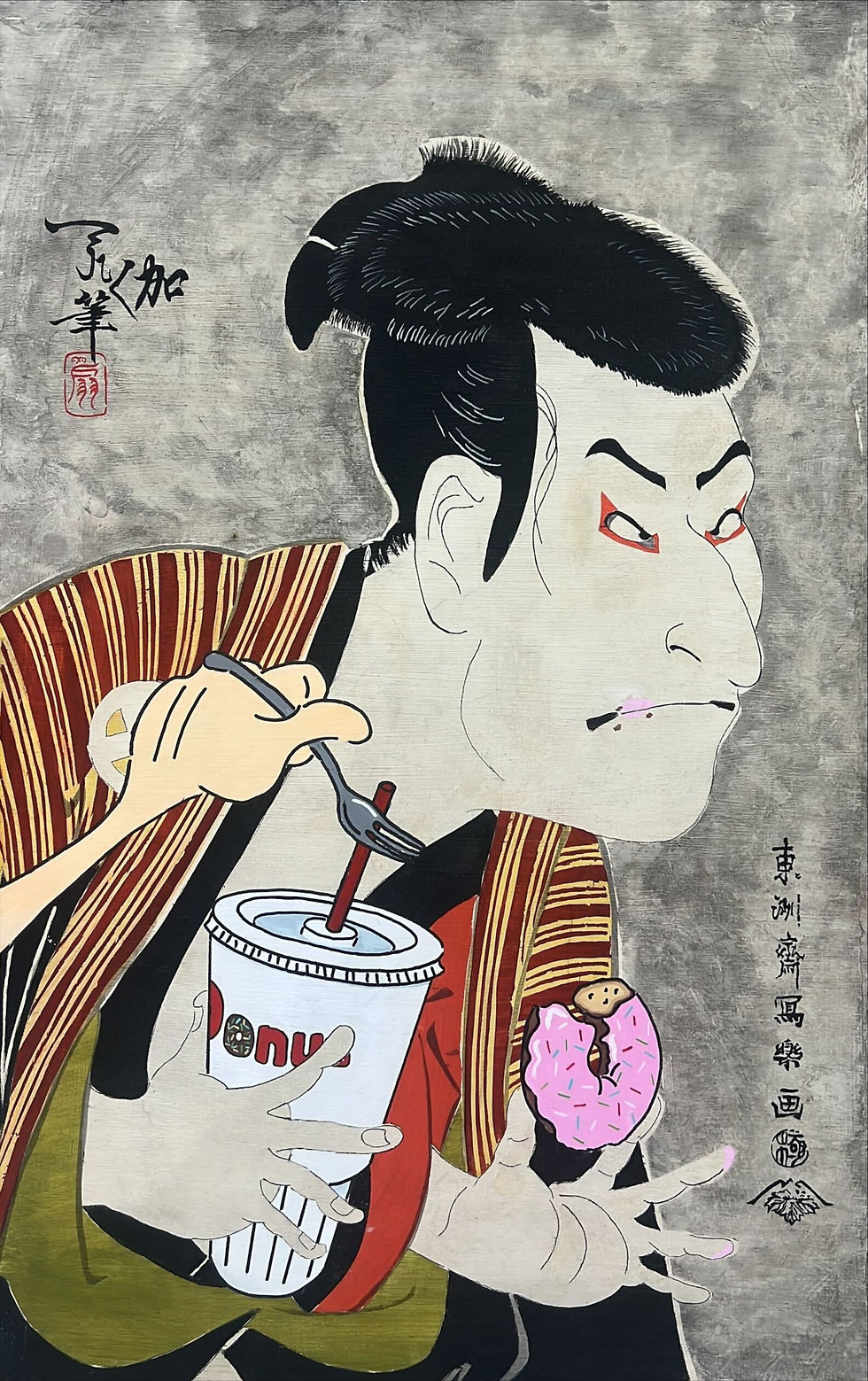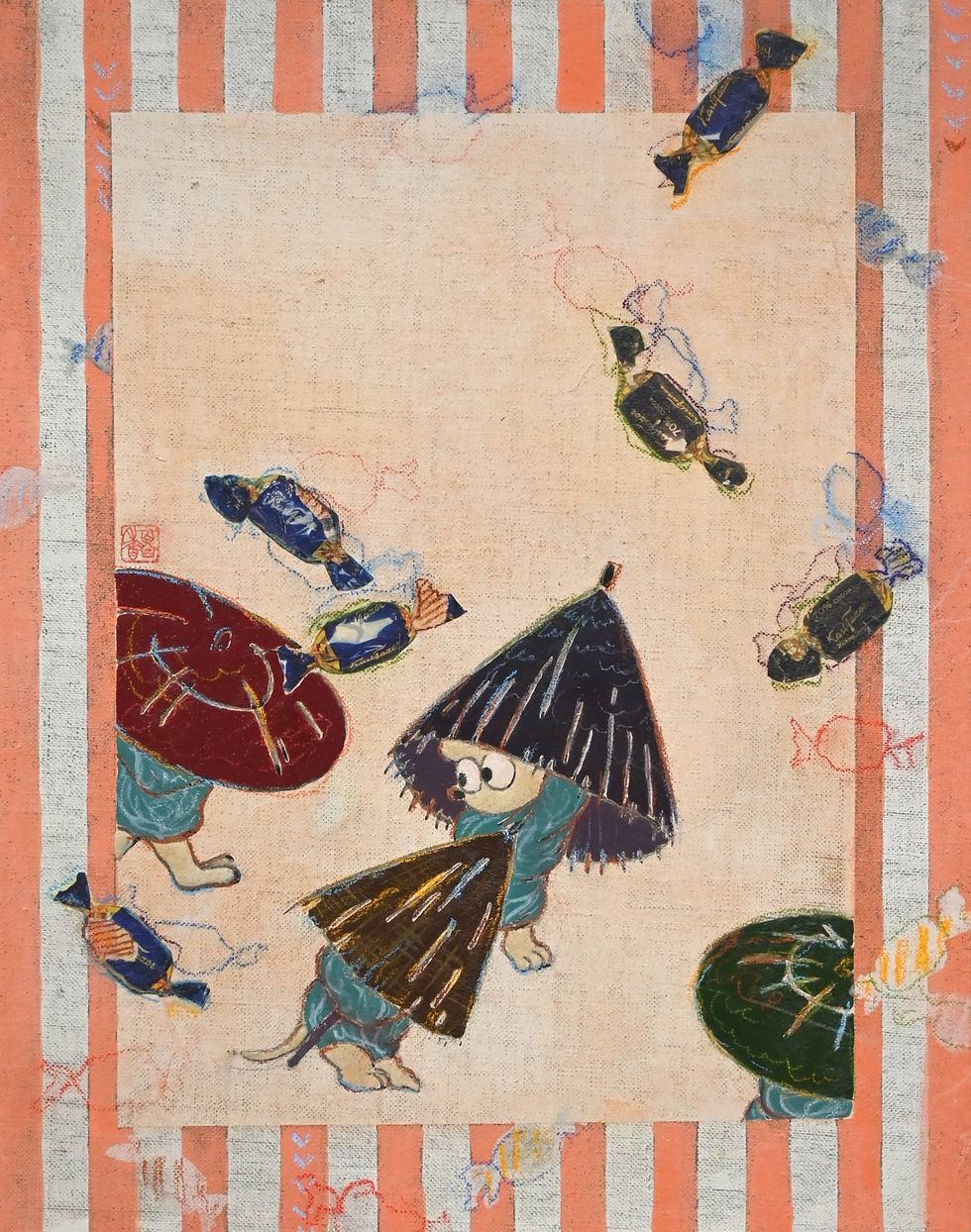Hitori Nohara×Yurika Hashimoto「Re: I 和」
- info9440318
- Aug 15
- 5 min read
Updated: Sep 1
2025.8.16 Sat - 8.31 Sun
SAN BANCHO GALLERY is pleased to present Re: I 和(Reiwa), a two-person exhibition by Hitori Nohara and Yurika Hashimoto, offering unique perspectives on the themes of “Japan” and “Wa” (harmony/Japanese culture).
This exhibition explores the concept of:“Re:” = reconstruction,“I” = myself,“Wa” = Japanese culture,and seeks to reconstruct “Wa” — hence Re: I Wa.
Hitori Nohara, an acrylic painter, reimagines ukiyo-e — a symbol of Japan — through the sensibilities of the Reiwa era.Yurika Hashimoto, guided by her own roots and sensibilities, creates works that honor both traditional Japanese painting materials and classical Western painting techniques.
We invite you to discover new visions of “Japan” and “Wa” as seen through the lens of the contemporary era.
About Re: I 和
Re: I 和 (Reiwa)
Re: — reply / reconstruction
I — myself / identity
Wa — Japanese culture
Contemporary artists reflect deeply on their own identities (I) and Japanese culture (Wa), perceiving and expressing them through their works.
The title Re: I 和 (Reiwa) layers the multiple meanings of the English “Re:” —
“Reply”
“Regarding”— along with the prefix “re-,” meaning “again.”
It is an exhibition that “reconsiders” past knowledge, experiences, and culture, reinterprets them in new forms, and “responds” through artistic expression. Re: I 和 is also an attempt to reconstruct both the self and Japanese culture through dialogue and response, questioning them from a contemporary perspective.
If you like, I can also refine this into a more art catalogue style so it reads even smoother for an English-speaking art audience. That would make it sound more elegant and natural for gallery press materials.
野原一人 Hitori Nohara
〇Biography
Born in 1987, Osaka, Japan
Graduated from the School of Human Sciences, Department of Human Environmental Sciences, Waseda University
Graduated from the Correspondence Course in Western Painting, Kyoto University of the Arts
〇Awards & Selected Exhibitions
2022 Finalist, KAYA Art Competition 2022
2024 Alumni Association Award, 2023 Graduation Works, Kyoto University of the Arts
2024 Finalist, Iime Fukurame in Osaka Selected Exhibitions
2022 KAYA Art Competition 2022, RAUM Togurajuku (Nagano)
2023 ACT Art Award 2022, The Artcomplex Center of Tokyo (Tokyo)
2024 Graduation Exhibition, Correspondence Course, Kyoto University of the Arts (Kyoto)
2024 Artist New Gate SAN BANCHO Selection, SAN BANCHO GALLERY (Tokyo)
2024 Iime Fukurame in Osaka, Daimaru Umeda (Osaka)
2024 KANZEN – Perfection, Isetan Shinjuku (Tokyo)
2024 Perspective – Young Artists Selection, Sendai Mitsukoshi (Miyagi)
〇Concept
Hitori Nohara is an acrylic painter who reinterprets the iconic imagery of Japanese ukiyo-e through the sensibilities of the Reiwa era.
Born in Osaka, Nohara grew up surrounded by a landscape where modern skyscrapers, ancient temples and shrines, and Showa-era buildings coexisted in a rich visual mix. This eclectic scenery sparked the question, “What is truly Japanese?” Nohara found his answer in landscapes where elements from different times and places blend and coexist.
The Japanese word wa (和) carries meanings such as “to harmonize” and “to bring together.” Since ancient times, Japan has built its unique culture by incorporating and merging diverse influences and technologies. Nohara interprets this spirit of fusion as a kind of “mash-up,” placing at the core of his work the creation of new value through the combination of seemingly different elements.
About This Series
For this series, Nohara focused on the distinct characteristics found in the works of Sharaku and Hokusai, along with the concept of mitate—a hallmark of Japanese culture. Mitate refers to the playful act of substituting one thing for another, as seen in dry landscape gardens, in the fan and props of rakugo performances, or, in contemporary times, in familiar products like the “Tsukimi Burger.”
Sharaku’s famous ōkubi-e (large-head portraits) are known for their distinctive depictions of hands. In these new works, Nohara reimagines those hands as “hands holding something,” and inserts images of American fast food. By combining two different cultural icons, he creates a new expression of wa, while also posing a subtle question: in today’s world, are we consuming Japanese culture with the same casual, snack-like attitude that we consume fast food?

Hokusai’s Thirty-six Views of Mount Fuji is renowned for its unique composition, in which Mount Fuji—the main subject—is placed in the background, while scenes of people’s daily lives of the time are boldly depicted in the foreground. This shift in perspective is one of Hokusai’s distinctive appeals.
In this work, that technique of “pushing the main subject into the distance” is reinterpreted in a contemporary context, bringing pets—now an indispensable part of our everyday lives—into the foreground. Buckets and wooden materials from the original print are reimagined as hamster wheels and cat scratching posts, capturing the sense of life and gestures of these animals.

Combining Sharaku’s expressive portrayal of hands, Hokusai’s mastery of composition, and the distinctly Japanese sensibility of mitate, the work reconstructs these elements through contemporary themes and motifs.
橋本百合香 Yurika Hashimoto
〇Biography
1998 Born in Hiroshima, Japan
2022 Graduated from Kyoto University of the Arts (formerly Kyoto University of Art and Design), Department of Fine and Applied Arts, Japanese Painting Course
2024 Completed Master’s Program in Fine and Applied Arts, Japanese Painting, Graduate School of Kyoto University of the Arts
Exhibition History
2020 "Kyoto Shinkin Bank 2021 Desk Calendar Original Artwork Production Project" – March Artwork
Kyoto Shinkin Bank, Kyoto
2021 "Gashin Exhibition – Hōko Exhibition" – Kyoto University of the Arts, Kyoto
"6th Masao Ishimoto Japanese Painting Award Exhibition" – Selected
Hamada City Sekishō Art Museum, Shimane
2022 "Porsche Art Museum" – Awarded the Baiken Gallery Prize and the Gondola Pastel Prize
Porsche Center Kyoto, Kyoto
"Various Colors – Hashimoto Yurika × Yoshimura Orina" – gallery718, Hiroshima
2023 "Exhibition – Flowers: Mono no Aware" – Gallery MOS, Mie
"Kamigamo Shrine Art Project 13th" – Kamigamo Shrine, Kyoto
2024 "Kyoto University of the Arts Graduate Exhibition" – Kyoto University of the Arts, Kyoto
"Saturday Night Once More" – WaLL_alternative, Tokyo
"What Appears, What Disappears" – Art Gallery Kitano, Kyoto
2025 "Peering Beneath the Daytime Stars" – Shimokitazawa Arts, Tokyo
〇Concept
Yurika Hashimoto’s artistic practice challenges the “fixed notions of techniques and materials” in contemporary Japanese painting.
She questions the conventional view that the use of washi paper and mineral pigments alone defines Japanese painting—a doubt rooted in her personal background: her mother is Japanese, but she herself was raised in Brazil. This sense of unease toward the simplistic idea that “being born and raised in Japan makes one Japanese” serves as a driving force for her expressions that blur and challenge boundaries.
Hashimoto finds the essence of Japanese sensibility in the animal paintings of Edo-period masters Itō Jakuchū and Nagasawa Rosetsu. Their works, in which technical mastery coexists with a sense of softness, symbolize the emotional richness of the Japanese spirit. For Hashimoto, the mouse that often appears in her works is both a symbol of her childhood memories and a representation of herself. In particular, the image of a mouse within a cage reflects the condition of modern individuals swayed by the dominant values of the majority.

In her practice, Hashimoto questions the meaning of materials and techniques, while incorporating elements of Western painting, ink expression, and knowledge of animal glue, in pursuit of new possibilities for artistic expression. She also employs collage as a method embodying the uniquely Japanese sensibility of “accepting things as they are.” Her approach resonates with that of Shinro Ohtake, particularly in embracing chance and irregularities in the creative process.
In her works, immutable materials such as mineral pigments and ink are combined with materials like paper and gold leaf, which change over time. She accepts fading and discoloration as part of the artwork, believing that the accumulated time and memories continue to reside within it. Like graffiti seen on foreign street corners—humorous yet carrying a strong message—she aims to create paintings that linger in the viewer’s mind across time.
SAN BANCHO GALLERY
三番町ギャラリー




Comments